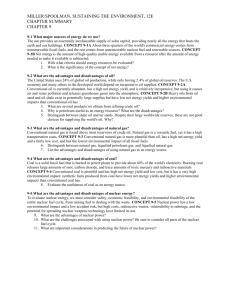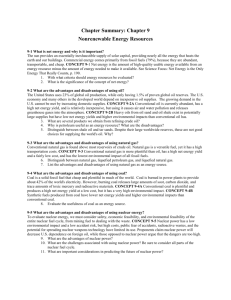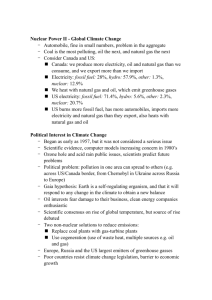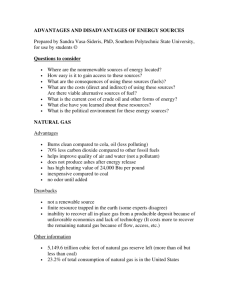Chapter 15: Nonrenewable Energy
advertisement
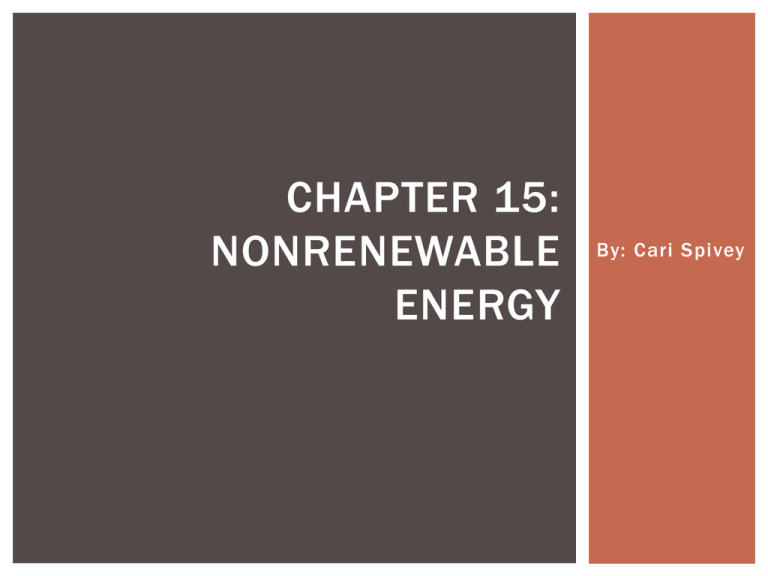
CHAPTER 15: NONRENEWABLE ENERGY By: Cari Spivey WHAT IS NET ENERGY AND WHY IS IT IMPORTANT? The two laws of thermodynamics govern all physical and chemical changes involved in the use of fossil fuels and other energy alternatives. The first law of thermodynamics, it takes high -quality energy to get high-quality energy. For example, before oil becomes useful to us, it must be found, pumped up from beneath the ground or ocean floor, transferred to a refinery, converted to useful fuels, and delivered to consumers. Each of these steps uses high -quality energy, mostly obtained by burning fossil fuels such as oil and coal. The second law of thermodynamics tells us that some of the high-quality energy used in each step is automatically wasted and degraded to lower-quality energy. No matter how hard we try, we cannot violate the two scientific laws of thermodynamics . The usable amount of high -quality energy available from a given quantity of an energy resource is its net energy. The total amount of useful energy available from an energy resource minus the energy needed to make it available to consumers It is calculated by estimating the total amount of energy available from the resource over its projected lifetime and then subtracting the estimated amount of energy used, automatically wasted because of the second law of thermodynamics, and unnecessarily wasted in finding, extracting, processing, and transporting the useful energy to consumers . Net energy is like the net profit earned by a business after it deducts its expenses . We can express net energy as the ratio of energy produced to the energy used to produce it. The net energy ratio would be 10/9, or approximately 1 .1 . As the ratio increases, its net energy yield also rises. Any energy resource with a low or negative net energy yield cannot compete in the open marketplace with other energy alternatives with higher net energy yields unless it is subsidized by the government or by some other outside source of funding . Relying on these energy resources is like investing in a business that has a low profit or that always loses money unless the government or some outside benefactor holds it up. Another component of any net energy ratio is the energy that is unnecessarily wasted in making useful energy available for use. We can control this factor by reducing such unnecessary waste and thus raising the net energy yield of a resource . Roughly 41% of all commercial energy is automatically wasted because of the second law of thermodynamics. Americans unnecessarily waste about 43% (the rest of the total wasted 84%). WHAT ARE THE ADVANTAGES AND DISADVANTAGES OF USING OIL? Oil supplies about one-third of the world’s commercial energy and 40% of that used in the United States. Oil is the lifeblood of most of the world’s economies and modern lifestyles and is the world’s largest business. We use oil to grow most of our food, transport people and goods, and make most of the things we use every day, from plastics to asphalt on roads. Petroleum, or crude oil, is a black, gooey liquid consisting of hundreds of different combustible hydrocarbons along with small amounts of sulfur, oxygen, and nitrogen impurities. This conventional oil, also known as light or sweet crude oil, makes up about 30% of the world’s estimated supply of oil. Deposits of conventional crude oil and natural gas often are trapped together under domes deep within the earth’s crust on land or under the seafloor. After years of pumping, usually a decade or so, the pressure in a well drops and its rate of conventional crude oil production starts to decline. This point in time is referred to as peak production for the well. The same thing can happen to a large oil field when the overall rate of production from its numerous wells begins to decline. Global peak production is the point in time when we reach the maximum overall rate of conventional crude oil production for the whole world. Once we pass this point, the rate of global production of conventional oil begins to decline. If we continue using conventional oil faster than we can produce it, its price rises. Some of the products of crude oil distillation, called petrochemicals, are used as raw materials in industrial organic chemicals, cleaning fluids, pesticides, plastics, synthetic fibers, paints, medicines, and many other products. World oil consumption has been growing rapidly since 1950 and conventional crude oil is now the single largest source of commercial energy in the world and in the United States. Proven oil reserves are identified deposits from which conventional crude oil can be extracted profitably at current prices with current technology. Other deposits of potentially recoverable oil are classified as unproven reserves. They consist of probable reserves with a 50% chance of recovery and possible reserves with a 10% to 40% chance of recovery. The world is not about to run out of conventional oil in the near future. Geologists project that proven and unproven global reserves of conventional crude oil will be 80% depleted sometime between 2050 and 2100, depending on consumption rates. It is extracted from crushed oil shales after they are heated in a large container, a process that yields a distillate called shale oil. WHAT ARE THE ADVANTAGES AND DISADVANTAGES OF USING NATURAL GAS? Natural gas is a mixture of gases of which 50 –90% is methane and it also contains smaller amounts of heavier gaseous hydrocarbons such as propane and butane, and small amounts of highly toxic hydrogen sulfide. It is a versatile fuel with a high net energy yield that can be burned to heat space and water, to produce electricity, and to propel vehicles. Conventional natural gas lies above most reservoirs of crude oil. When a natural gas field is tapped, propane and butane gases are liquefied under high pressure and removed as liquefied petroleum gas. LPG is stored in pressurized tanks for use mostly in rural areas not served by natural gas pipelines. The rest of the gas is purified and pumped into pressurized pipelines for distribution across land areas. Russia, the Saudi Arabia of natural gas, has about 25% of the world’s proven natural gas reserves, followed by Iran and Qatar. The United States has only 3.4% of the world’s proven natural gas reserves but uses about 22% of the world’s annual production. Burning natural gas releases the greenhouse gas carbon dioxide and several other air pollutants into the atmosphere. Natural gas can be converted to liquefied natural gas at a high pressure and at the very low temperature of about –162 oC. There are also several sources of unconventional natural gas and one is coal bed methane gas found in coal beds near the earth’s surface across parts of the United States and Canada. Another is natural gas trapped in underground shale beds that are found in many parts of the United States and that could meet U.S. natural gas needs for up to 100 years. Residents of the United States who rely on aquifers for their drinking water have little protection from pollution of their water supplies from these two unconventional sources of natural gas because the 2005 Energy Policy Act excluded natural gas companies from regulation under U.S. water pollution control laws. Another unconventional source is methane hydrate, methane trapped in icy, cage-like structures of water molecules. it costs too much to get natural gas from methane hydrates, and the release of methane to the atmosphere during removal and processing would speed up atmospheric warming and the resulting climate change . WHAT ARE THE ADVANTAGES AND DISADVANTAGES OF USING COAL? Coal is a solid fossil fuel that was formed in several stages from of the remains of land plants that were buried 300 –400 million years ago and then exposed to intense heat and pressure over those millions of years. Coal is responsible for 42 % of the world’s electricity, 46% of the electricity used in the United States, and 70% of that in China and it is also burned in industrial plants to make steel, cement, and other products . Coal is the world’s most abundant fossil fuel, and the world has depended on it as a major energy resource for several hundred years. Identified and unidentified global supplies of coal could last for 214–1 ,125 years, depending on how rapidly they are used. The U.S. Geological Survey estimates that identified U.S. coal reserves should last about 250 years at the current consumption rate. The problem is that coal is by far the dirtiest of all fossil fuels and before it is even burned, the processes of making it available severely degrade land and pollute water and air. When coal is burned without expensive pollution control devices, it severely pollutes the air. Coal is mostly carbon but contains small amounts of sulfur, which is released into the air as sulfur dioxide when the coal burns. According to a 2007 study by the Center for Global Development, coal-burning power plants account for 25% of all human generated CO2 emissions in the world, and 40% of such emissions in the United States . Another problem with burning coal is that it emits trace amounts of radioactive materials as well as toxic and indestructible mercury into the atmosphere . A coal-burning power plant releases about 100 times more radioactivity into the atmosphere than does a nuclear power plant with the same energy output . The use of coal is growing, especially in China, which has relied on coal to help fuel its rapid economic growth. In 2009, on average, China was building the equivalent of one large coal-fired power plant every week, most of them without modern air pollution control equipment. We can convert solid coal into synthetic natural gas by a process called coal gasification, which removes sulfur and most other impurities from coal. We can also convert coal into liquid fuels such as methanol and synthetic gasoline through a process called coal liquefaction. We can also convert coal into liquid fuels such as methanol and synthetic gasoline through a process called coal liquefaction. WHAT ARE THE ADVANTAGES AND DISADVANTAGES OF USING NUCLEAR ENERGY? Nuclear power is a source of energy that we learned how to use fairly recently, primarily for generating electricity. A nuclear power plant is a highly complex and costly system designed to per- form a relatively simple task: to boil water and produce steam that spins a turbine and generates electricity. The fission reaction takes place in a reactor and the most common reactors, called light -water reactors, produce 85% of the world’s nuclear-generated electricity. Control rods are moved in and out of the reactor core to absorb neutrons, thereby regulating the rate of fission and amount of power produced. A containment shell with thick, steel -reinforced concrete walls surrounds the reactor core. A nuclear power plant is only one part of the nuclear fuel cycle, which also includes the mining of uranium, processing and enriching the uranium to make fuel, using it in a reactor, and safely storing the resulting highly radioactive wastes, in the form of depleted or spent fuel rods, for thousands of years until their radioactivity falls to safe levels. Each step in the nuclear fuel cycle adds to the cost of nuclear power and reduces its net energy yield. In the 1950s, researchers predicted that by the year 2000, at least 1 ,800 nuclear power plants would supply 21% of the world’s commercial energy and most of the world’s electricity. The U.S. government has provided huge subsidies, tax breaks, and loan guarantees to the nuclear power industry. Chernobyl is known around the globe as the site of the world’s most serious nuclear power plant accident. According to UN studies, the Chernobyl disaster was caused by a poor reactor design and by human error, and it had serious consequences. After about 3 or 4 years, the high -grade uranium fuel in a nuclear reactor becomes spent, or useless, and must be replaced. A 2005 study by the U.S. National Academy of Sciences warned that the intensely radioactive waste storage pools and dry casks at 68 nuclear power plants in 31 U.S. states are especially vulnerable to sabotage or terrorist attack. The long-term goal is to find a way to store these dangerous radioactive wastes safely at a central site . THREE BIG IDEAS A key factor to consider in evaluating the usefulness of any energy resource is its net energy yield. Conventional oil, natural gas, and coal are plentiful and have moderate to high net energy yields, but using any fossil fuel, especially coal, has a high environmental impact. Nuclear power has a low environmental impact and a very low accident risk, but high costs, a low net energy yield, long -lived radioactive wastes, and the potential for spreading nuclear weapons technology have limited its use.


